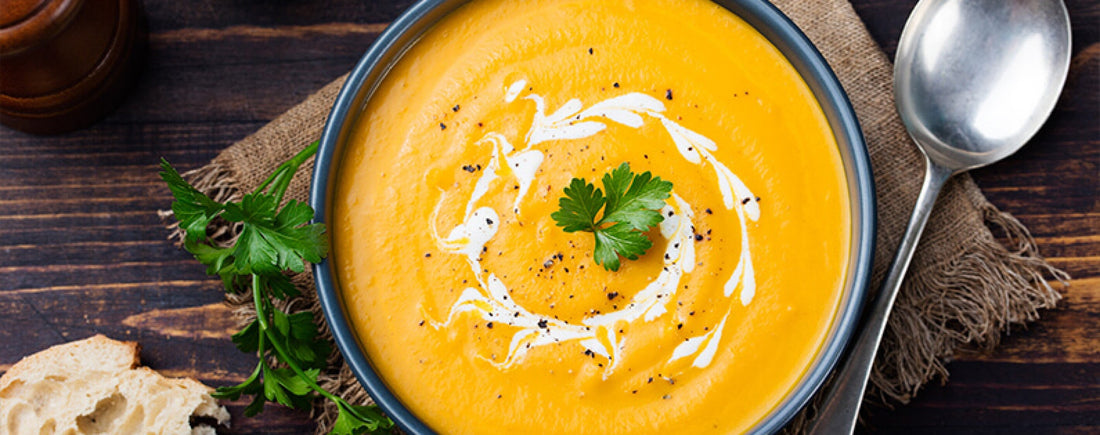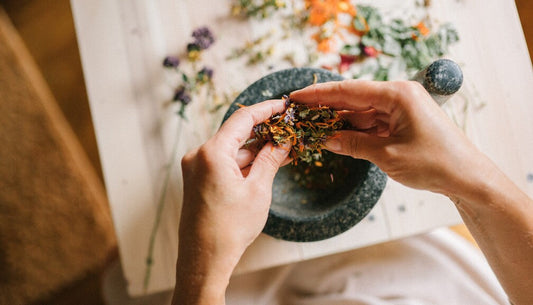Ahh, fall — the beautiful autumn foliage, pumpkin picking, and drinking warm apple cider as the air cools and the wind picks up. Just as doshas govern your constitution, they also govern the seasons. Summer has transitioned into fall, which is considered to be the Vata time of the year. The Vata dosha is made of the elements air and space, and its qualities are light, cold, dry, and mobile. These qualities dominate (depending on where you live) as summer turns to fall; you are faced with cooler temperatures and windier conditions (think of a crisp, windy fall day). Leaves begin to turn color. It is a glorious time of year, especially in parts of the country that are blessed to have amazing fall foliage.
According to Ayurveda, “like increases like,” so if you have a predominance of Vata in your constitution or have a Vata imbalance, you will have to baby your Vata even more during the Vata season. That means bringing in the opposite qualities—heavy, warm, moist, and grounding (through food and lifestyle practices). Here are some Ayurvedic protocols to keep you warm, grounded, and nourished this autumn.
Start your day with a bowl of nourishing oatmeal cooked with some apple and spiced with ginger and cinnamon. Favor warm (cooked foods), especially soups and stews. (See below for a couple of Vata-pacifying fall recipes.)
Postures should be held for a longer period of time, anywhere from 5–10 breaths at least, if not longer. Some wonderful Vata-pacifying postures are:
The first chakra is also known as the root chakra as it roots and stabilizes you. It is energetically located at the base of your spine. Its core attributes are stability and security. The elemental energy is earth. The bija mantra of the root chakra is Lam. Chant this mantra (silently or aloud) with your eyes closed and inwardly focusing on this chakra to bring in the stable and grounding qualities of the earth.
The second (sacral) chakra is associated with creativity and sensuality and allows you to flow gracefully like water—the associated element of this chakra. It is energetically located in the lower abdomen/pelvic region, and the bija mantra is Vam. Chant this mantra (silently or aloud) with your eyes closed and inwardly focusing on this chakra to bring in the calming and flowing qualities of water.
Note: This meditation can be done either in a comfortable seated posture or lying down. Chant each mantra for anywhere from one to two minutes
Warm, nourishing, and spicy comfort in a bowl.
Ingredients:
Try this yummy and satisfying vegetable side.
Ingredients:
*Editor’s Note: The information in this article is intended for your educational use only; does not necessarily reflect the opinions of the Chopra Center's Mind-Body Medical Group; and is not a substitute for professional medical advice, diagnosis, or treatment. Always seek the advice of your physician or other qualified health providers with any questions you may have regarding a medical condition and before undertaking any diet, supplement, fitness, or other health program
According to Ayurveda, “like increases like,” so if you have a predominance of Vata in your constitution or have a Vata imbalance, you will have to baby your Vata even more during the Vata season. That means bringing in the opposite qualities—heavy, warm, moist, and grounding (through food and lifestyle practices). Here are some Ayurvedic protocols to keep you warm, grounded, and nourished this autumn.
1. Food — Warm, Nourishing, Grounding, and Well-Spiced
Tastes that pacify the Vata dosha are sweet, salty, and sour. Of these tastes, the sweet taste (made up of earth and water) is the most nourishing and grounding. Healthy examples of sweet-tasting foods include:- Grounding whole grains—oats, basmati rice, brown rice, wheat, quinoa
- Nuts
- Root vegetables—carrots, sweet potatoes, beets
- Pumpkin and winter squashes such as butternut
- Natural sweeteners—honey, molasses, raw cane sugar, maple syrup
- Healthy fats—ghee, almond oil, sesame oil, avocado oil
- Fruits—cooked apples, avocado, bananas, grapes, figs, mangoes, dates, soaked raisins and prunes
Start your day with a bowl of nourishing oatmeal cooked with some apple and spiced with ginger and cinnamon. Favor warm (cooked foods), especially soups and stews. (See below for a couple of Vata-pacifying fall recipes.)
2. Self-Massage — A Loving Way to Stay Nourished and Grounded
Self-massage equals self-love. Fall is the time to nourish yourself even more, with a warming and grounding abhyanga (self-massage) at least two to three times a week. Use Vata-pacifying oils such as almond and sesame oil warmed up to a comfortable temperature, and lovingly massage yourself. You can also add a few drops (1–2) of calming and Vata-pacifying essential oils like lavender, ylang ylang, or cedar wood to your massage oil.3. Aromatherapy and Essential Oils — Smell Your Way to Staying Balanced
Sweet and spicy essential oils calm and ground the Vata dosha. These include lavender, sweet orange, ylang ylang, rosemary, ginger, cedar wood, and frankincense. You can make as an aromatherapy spritzer or an oil blend, to use as needed to remain calm and grounded.Vata-Pacifying Aromatherapy Blend (Oil or Spritzer)
- 2 oz. jojoba oil (carrier oil) or 2 oz. distilled water
- 4 drops lavender essential oil
- 4 drops ylang ylang essential oil
- 3 drops rosemary
- 3 drops frankincense
4. Yoga — Cultivate Calm
A Vata-pacifying yoga practice should be done in a slow and mindful manner. The room should be sufficiently warm with the lights dimmed, if possible. Vigorous postures done in a speedy manner should be avoided. In general, forward bends and postures done close to the earth (seated postures rather than standing postures) pacify and calm the Vata dosha. You can do standing postures, provided they are performed in a slow and calming manner, with the postures held for a few breaths.Postures should be held for a longer period of time, anywhere from 5–10 breaths at least, if not longer. Some wonderful Vata-pacifying postures are:
- Standing mountain pose
- Standing forward bend
- Seated forward bend
- Gentle spinal twist
- Child’s pose
- Legs-up-the-wall pose
5. Chakra Meditation — Ground and Nourish
Specific chakras (energetic centers of transformation) are associated with specific elements. Chanting the bija mantra (seed mantra) for these chakras while focusing on their specific location can invite the qualities of these elements, along with the physical, emotional, and psycho-spiritual benefits associated with each chakra.The first chakra is also known as the root chakra as it roots and stabilizes you. It is energetically located at the base of your spine. Its core attributes are stability and security. The elemental energy is earth. The bija mantra of the root chakra is Lam. Chant this mantra (silently or aloud) with your eyes closed and inwardly focusing on this chakra to bring in the stable and grounding qualities of the earth.
The second (sacral) chakra is associated with creativity and sensuality and allows you to flow gracefully like water—the associated element of this chakra. It is energetically located in the lower abdomen/pelvic region, and the bija mantra is Vam. Chant this mantra (silently or aloud) with your eyes closed and inwardly focusing on this chakra to bring in the calming and flowing qualities of water.
Note: This meditation can be done either in a comfortable seated posture or lying down. Chant each mantra for anywhere from one to two minutes
Vata-Pacifying Recipes
Sweet Potato Bisque
Serves 4Warm, nourishing, and spicy comfort in a bowl.
Ingredients:
- 1 1/2 tablespoons organic sunflower oil
- 1/2 cup diced onions
- 1 garlic clove, minced
- 1 teaspoon minced fresh ginger
- 3 medium sweet potatoes, cut into approximately 1-inch cubes
- 3–3 1/2 cups water or organic broth
- 3/4 cup milk (dairy-free, such as almond or oat milk)
- 1/2 teaspoon cinnamon
- 1/4 teaspoon nutmeg
- 1/2 teaspoon fresh sage
- 1/2 teaspoon fresh thyme
- Walnuts, chopped
- Salt
- Heat the oil in a large saucepan over medium heat.
- Add the diced onions and stir well (you may have to lower the heat a bit to prevent burning). Next, add the garlic and ginger and continue to stir. Add the herbs and the spices and stir for a few seconds. Finally, add the sweet potato and stir well. Allow to cook for approximately 5 minutes, stirring often.
- When the sweet potatoes have softened a bit, add enough water or broth to cover the sweet potatoes, stir well, and turn the heat up. When the water or broth begins to slowly boil, reduce the heat to simmer and cover. Allow to cook for approximately 20 to 25 minutes, or until the sweet potatoes have softened.
- When the sweet potatoes are cooked through, blend all the ingredients together using an immersion blender or transfer to a regular blender. If using a regular blender, return the soup to the original saucepan. Reduce the heat to low, add milk, and stir well. Add salt to taste just before turning off the stove.
- Top with chopped walnuts.
Indian-Spiced Butternut Squash
Serves 4Try this yummy and satisfying vegetable side.
Ingredients:
- 2 cups butternut squash, cubed
- 2 cups yellow, orange, and red bell pepper, diced
- 1 cup kale, chopped
- 2 tablespoons sunflower oil
- 1 tablespoon ghee (optional)
- 1 tablespoon ginger, sliced
- 1/2 teaspoon turmeric
- 1/2 cup golden raisins
- Salt
- Garam masala (spice mixture)—1/8–1/4 teaspoon each ground cloves, ground cinnamon, ground nutmeg, ground cardamom, and ground coriander
- Coriander, chopped (optional)
- Dill leaves, chopped (optional)
- Add the oil and ghee to pan (medium flame). Add ginger and stir for a few seconds.
- Add the turmeric and ground spice mixture (garam masala). Stir spices for 10–15 seconds, until fragrant.
- Add the raisins and sauté for a few seconds. Add the butternut squash and coat with spices as you stir.
- Cover the pan and let the squash cook for 3–4 minutes, stirring as necessary, so that the mixture does not stick to the bottom of the pan. Add the bell peppers to the mixture and stir.
- Cover and cook for 2–3 minutes. Add a little bit of water, if necessary (up to 1/4 cup). Stir. Let the mixture cook for another 7–8 minutes.
- Add the kale 3–4 minutes before switching off stove and stir.
- Add salt and turn off the stove when vegetables are cooked.
- Garnish with chopped coriander or dill leaves (optional).
- Enjoy with basmati rice or flatbread.
*Editor’s Note: The information in this article is intended for your educational use only; does not necessarily reflect the opinions of the Chopra Center's Mind-Body Medical Group; and is not a substitute for professional medical advice, diagnosis, or treatment. Always seek the advice of your physician or other qualified health providers with any questions you may have regarding a medical condition and before undertaking any diet, supplement, fitness, or other health program






















